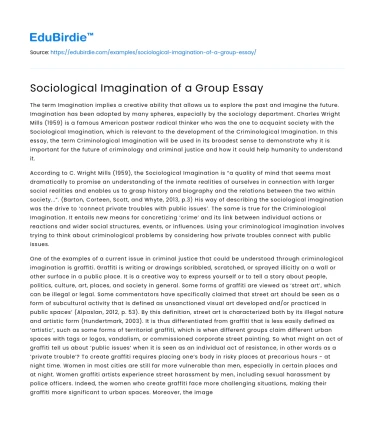The term Imagination implies a creative ability that allows us to explore the past and imagine the future. Imagination has been adopted by many spheres, especially by the sociology department. Charles Wright Mills (1959) is a famous American postwar radical thinker who was the one to acquaint society with the Sociological Imagination, which is relevant to the development of the Criminological Imagination. In this essay, the term Criminological Imagination will be used in its broadest sense to demonstrate why it is important for the future of criminology and criminal justice and how it could help humanity to understand it.
According to C. Wright Mills (1959), the Sociological Imagination is “a quality of mind that seems most dramatically to promise an understanding of the inmate realities of ourselves in connection with larger social realities and enables us to grasp history and biography and the relations between the two within society...”. (Barton, Corteen, Scott, and Whyte, 2013, p.3) His way of describing the sociological imagination was the drive to ‘connect private troubles with public issues’. The same is true for the Criminological Imagination. It entails new means for concretizing ‘crime’ and its link between individual actions or reactions and wider social structures, events, or influences. Using your criminological imagination involves trying to think about criminological problems by considering how private troubles connect with public issues.
Save your time!
We can take care of your essay
- Proper editing and formatting
- Free revision, title page, and bibliography
- Flexible prices and money-back guarantee
One of the examples of a current issue in criminal justice that could be understood through criminological imagination is graffiti. Graffiti is writing or drawings scribbled, scratched, or sprayed illicitly on a wall or other surface in a public place. It is a creative way to express yourself or to tell a story about people, politics, culture, art, places, and society in general. Some forms of graffiti are viewed as ‘street art’, which can be illegal or legal. Some commentators have specifically claimed that street art should be seen as a form of subcultural activity that is defined as unsanctioned visual art developed and/or practiced in public spaces’ (Alpaslan, 2012, p. 53). By this definition, street art is characterized both by its illegal nature and artistic form (Hundertmark, 2003). It is thus differentiated from graffiti that is less easily defined as ‘artistic’, such as some forms of territorial graffiti, which is when different groups claim different urban spaces with tags or logos, vandalism, or commissioned corporate street painting. So what might an act of graffiti tell us about ‘public issues’ when it is seen as an individual act of resistance, in other words as a ‘private trouble’? To create graffiti requires placing one’s body in risky places at precarious hours - at night time. Women in most cities are still far more vulnerable than men, especially in certain places and at night. Women graffiti artists experience street harassment by men, including sexual harassment by police officers. Indeed, the women who create graffiti face more challenging situations, making their graffiti more significant to urban spaces. Moreover, the images and texts that many of these female artists create have an important social message. Putting themselves at risk to produce art (much of it political) is a claim to the right to the city: a demand to be safe and to be able to engage in producing urban space. Yet, there are many great female graffiti artists, and the number is growing. In 2010, several women from Nicaragua and Costa Rica formed to create Las Destructoras (or Ladies Destroying Crew). These grafiteras have painted graffiti in Managua, San José, and several other cities. Most of their work has comprised tagging words, such as mujeres libres, fuertes, belas (free, strong, beautiful women), and female figures, along with their tag names. For women, making graffiti - being in public (usually in groups) - is a rebellious act that disrupts the usual perception of young men transforming city spaces. It provides a sense of power over the city, their bodies, and the public in relaying messages. In Nicaragua, the group has given workshops on graffiti to women in Managua and other cities. That graffiti art in many cities is dominated by men means that even within marginalized productions of urban space, women’s art and voices remain side-lined and out of the public view. In this regard, the growing number of women graffiti artists is a positive force within communities. These women are helping make urban spaces, especially public and street spaces safer by making their own presence visible - not only by putting their bodies physically in these spaces when they create the art, but also through the female images and messages they leave behind. Such messages may help to generate discussions about street safety, harassment, and women’s roles in public art. Allowing young women to engage in graffiti may also help build confidence. The workshops that Ladies Destroying Crew has given on graffiti are one way to cultivate a culture of women and graffiti. Perhaps there are other ways that communities, organizations, and cities can use graffiti as a way to bring about more gender equity in urban spaces.
Taking graffiti as an example, it becomes a little clearer that criminological imagination helps to look at the issue from different perspectives. Graffiti is a social activity that attracts widely differing public opinions on how it should be understood or responded to and whether it should be controlled and punished or embraced and celebrated. Thinking about the different ways graffiti can be thought about and understood opens up questions about what is and isn’t defined as a crime and how public opinion can differ on what should or shouldn’t be deemed illegal.






 Stuck on your essay?
Stuck on your essay?

